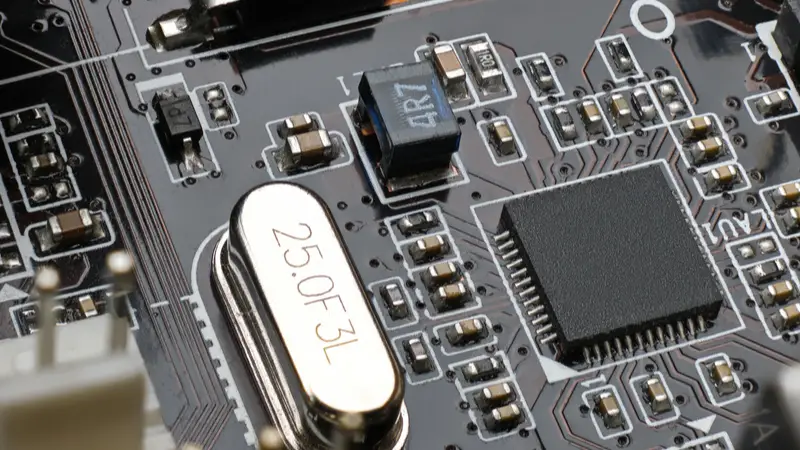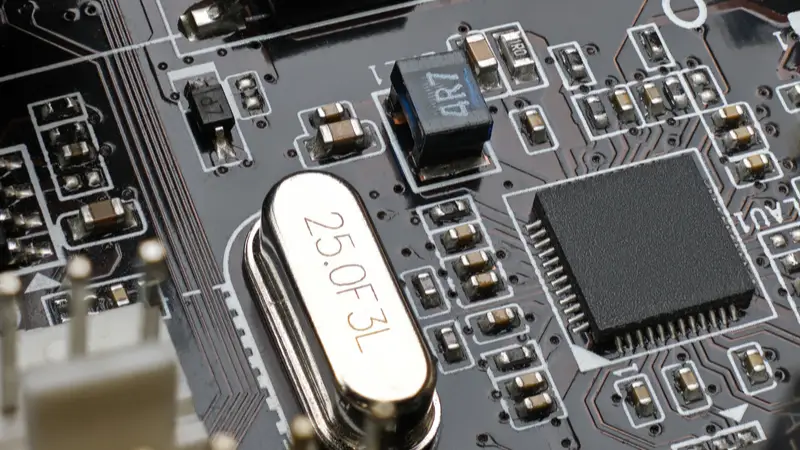Crystal oscillators are the unsung heroes of modern electronics, providing the precise timing that underpins countless devices. From the clock on your wrist to the complex communication systems that connect the world, these tiny components play a vital role.
This blog post will delve into the diverse applications of crystal oscillators, showcasing their importance in various industries and technologies. We’ll explore how their unique properties make them indispensable for accurate timekeeping, signal generation, and synchronization.
What Are Crystal Oscillators

Crystal oscillators are electronic circuits that generate precise and stable electrical signals using the mechanical resonance of a vibrating crystal, most commonly quartz. This crystal exhibits the piezoelectric effect, meaning it vibrates at a specific frequency when an electrical voltage is applied, and conversely, generates a voltage when mechanically stressed.
These oscillators are fundamental components in a vast array of electronic devices due to their exceptional accuracy and stability. They serve as reliable timing sources in applications ranging from simple wristwatches to complex communication systems and computers, providing the essential clock signals required for synchronized operation.
Crystal Oscillator Applications

1. Timekeeping and Real-Time Clocks (RTCs)
Crystal oscillators, specifically those operating at 32.768 kHz, are the cornerstone of accurate timekeeping in devices ranging from wristwatches to sophisticated industrial control systems. This frequency is chosen because it can be easily divided down to 1 Hz, providing a precise second pulse. The stability of quartz crystals ensures that time is kept accurately over long periods, minimizing drift and errors. In RTCs, they maintain the time and date even when the main power is off, relying on a small backup battery.
In applications requiring precise time synchronization, like GPS receivers or network servers, crystal oscillators provide the fundamental timing reference. They ensure that all operations are coordinated, preventing data corruption and timing discrepancies. This is vital in financial transactions, telecommunications, and scientific research where accurate timestamps are crucial.
2. Communication Systems
Crystal oscillators play a pivotal role in generating stable carrier frequencies for wireless communication systems, including cellular networks, radio transmitters, and satellite communication. In these applications, the accuracy of the carrier frequency is paramount for efficient signal transmission and reception. They enable precise tuning and demodulation, ensuring that signals are transmitted and received without interference.
In digital communication systems, crystal oscillators provide the clock signals for data transmission and synchronization. They maintain the bit rate and timing accuracy required for reliable data transfer, preventing errors and ensuring that data is transmitted and received correctly. This is particularly important in high-speed data communications, where even small timing errors can lead to significant data loss.
3. Computing Devices
Crystal oscillators are essential for providing the clock signals that synchronize the operation of CPUs, microprocessors, and other digital circuits in computers, laptops, and servers. They dictate the speed at which the processor executes instructions, directly influencing the overall performance of the system. The stability of crystal oscillators ensures that operations are performed accurately and consistently.
In embedded systems and microcontrollers, crystal oscillators provide the timing reference for various peripherals, such as timers, counters, and communication interfaces. They enable precise control of timing-sensitive operations, such as motor control, sensor data acquisition, and communication protocols. This is crucial in applications ranging from automotive electronics to industrial automation.
4. Consumer Electronics
Crystal oscillators are found in a wide range of consumer electronics devices, including digital cameras, televisions, audio equipment, and gaming consoles. They provide the timing signals for signal processing, data conversion, and synchronization, ensuring that these devices operate correctly and reliably. They are used in audio equipment for accurate sampling rates, in cameras for precise shutter timing, and in televisions for stable image display.
In devices with wireless connectivity, such as smartphones and tablets, crystal oscillators provide the carrier frequencies for Wi-Fi, Bluetooth, and cellular communication. They enable seamless connectivity and reliable data transfer, ensuring that these devices can communicate with other devices and networks.
5. Automotive Electronics
Crystal oscillators are critical components in automotive electronics, providing the timing signals for engine control units, GPS navigation systems, and other automotive applications. They ensure that these systems operate accurately and reliably, contributing to the safety and performance of the vehicle. In engine control units, they provide the timing reference for fuel injection, ignition, and other critical functions.
In GPS navigation systems, crystal oscillators provide the timing signals for satellite signal processing and position calculation. They enable accurate and reliable navigation, ensuring that the vehicle can determine its location and provide accurate directions. They are also used in automotive communication systems, such as keyless entry and remote start, to ensure secure and reliable communication.
6. Industrial Applications
Crystal oscillators are widely used in industrial control systems, instrumentation, and measurement equipment, where accuracy and stability are paramount. They provide the timing signals for various sensors, actuators, and control circuits, ensuring that these systems operate correctly and reliably. In process control systems, they ensure the precise timing of events, such as valve operation and temperature control.
In measurement equipment, crystal oscillators provide the timing reference for accurate measurements of frequency, time, and other parameters. They are used in oscilloscopes, frequency counters, and other instruments to ensure accurate and reliable measurements. In industrial automation, they are used in robotic systems, conveyor belts, and other automated processes to ensure precise timing and coordination.
7. Aerospace and Military
Crystal oscillators are essential components in aerospace and military applications, where high stability and accuracy are critical. They are used in navigation systems, guidance systems, and communication equipment, ensuring that these systems operate reliably in harsh environments. In navigation systems, they provide the timing signals for satellite signal processing and position calculation.
In guidance systems, crystal oscillators provide the timing reference for inertial navigation and other guidance functions. They ensure that missiles, aircraft, and other vehicles can accurately determine their position and orientation. In military communication systems, they provide the carrier frequencies for secure and reliable communication.
Crystal Oscillator Uses in the following chart
| Application | Key Function | Frequency Range |
| Timekeeping/RTCs | Accurate time and date tracking | 32.768 kHz |
| Communication Systems | Carrier frequency generation, data synchronization | MHz ranges |
| Computing Devices | CPU/microprocessor clock signals | MHz ranges |
| Consumer Electronics | Signal processing, data conversion | kHz to MHz |
| Automotive Electronics | Engine control, GPS navigation | MHz ranges |
| Industrial Applications | Control systems, instrumentation | kHz to MHz |
| Aerospace/Military | Navigation, guidance, communication | MHz ranges |
Crystal Oscillator Use in Microcontroller

Why use crystal oscillator in microcontroller?
Crystal oscillators are vital components within microcontroller systems, providing the precise timing that these devices require to function correctly. Here’s a look at their key role:
Clock Signal Generation:
Microcontrollers execute instructions based on clock cycles. A crystal oscillator provides a stable and accurate clock signal, ensuring that these cycles occur at the correct intervals. This precise timing is essential for the microcontroller to perform its tasks reliably. Without a stable clock source, the microcontroller’s operations would become erratic and unpredictable.
While some microcontrollers have internal oscillators, these often lack the accuracy and stability of external crystal oscillators. For applications demanding precise timing, such as communication protocols or real-time control, an external crystal oscillator is crucial. It ensures that the microcontroller’s operations are synchronized and consistent.
Synchronization and Accuracy:
Microcontrollers frequently interact with other electronic components, and these interactions often require synchronized timing. Crystal oscillators provide the timing reference that allows these interactions to occur smoothly. For example, in communication protocols like UART or SPI, precise timing is essential for the correct transmission and reception of data.
Many microcontroller applications require accurate timekeeping or the precise measurement of time intervals. Crystal oscillators provide the stability needed for these applications. Whether it’s controlling a motor, reading sensor data, or managing a communication link, the crystal oscillator ensures that the microcontroller operates with the necessary precision.
How to Use Crystal Oscillator in Circuit
Using a crystal oscillator in a circuit involves connecting the crystal to an appropriate oscillator circuit, which often includes the microcontroller itself or a dedicated oscillator IC. Here’s a general guide:
1. Understanding the Crystal Specifications:
- Frequency: Determine the required frequency for your application.
- Load Capacitance (CL): This is crucial. The crystal’s datasheet specifies the required load capacitance, typically in picofarads (pF).
- Equivalent Series Resistance (ESR): This indicates the crystal’s internal resistance and affects the oscillator’s stability.
2. Choosing the Oscillator Circuit:
- Microcontroller’s Oscillator Circuit: Many microcontrollers have built-in oscillator circuits designed to work with external crystals. Consult the microcontroller’s datasheet for the recommended configuration.
- Dedicated Oscillator ICs: For applications requiring higher stability or specific features, dedicated oscillator ICs can be used.
3. Implementing the Circuit:
- Connecting the Crystal: Connect the crystal to the designated pins on the microcontroller or oscillator IC.
- Load Capacitors: Add load capacitors (CL) between each crystal pin and ground. The values of these capacitors are critical for achieving the correct oscillation frequency. Calculate the load capacitance using the equation: CL = (C1 * C2) / (C1 + C2) + stray capacitance. Where C1 and C2 are the load capacitors.
- Series Resistor (Optional): In some cases, a series resistor may be added to limit the drive level to the crystal and improve stability. Consult the crystal’s datasheet for recommendations.
- Decoupling Capacitors: Add decoupling capacitors near the power supply pins of the microcontroller or oscillator IC to minimize noise.
4. Example Circuit (Microcontroller):
- Connect one end of the crystal to the microcontroller’s OSC1 pin.
- Connect the other end of the crystal to the microcontroller’s OSC2 pin.
- Connect a load capacitor (C1) from OSC1 to ground.
- Connect a load capacitor (C2) from OSC2 to ground.
- Consult the microcontrollers datasheet for proper capacitor values.
5. Considerations:
- PCB Layout: Keep the crystal and its associated components close to the microcontroller or oscillator IC to minimize stray capacitance and inductance.
- Shielding: In noisy environments, shielding the crystal oscillator circuit can improve stability.
- Testing: Use an oscilloscope to verify the oscillation frequency and waveform.
6. Datasheet is Key:
- Always refer to the datasheets of the crystal and the microcontroller or oscillator IC for specific recommendations and requirements.
By following these guidelines, you can effectively integrate a crystal oscillator into your circuit and achieve accurate and stable timing.
Conclusion
Crystal oscillators are indispensable in numerous electronic applications, providing the crucial timing signals that underpin their operation. From consumer electronics to industrial systems, their precision is paramount.
For a broad selection of high-quality crystal oscillators tailored to diverse needs, explore Weishi Electronics. Their catalog boasts solutions for various applications, ensuring reliability and accuracy.
Enhance your projects with precise timing by quoting Crystal Oscillators from Weishi Electronics today.